Cartoonist Jim Terry is drawn to demons, imaginative and real life. You know, the ones that get their fangs in you and drain you of your life force beyond repair. He’s battled demons head-on for decades. He’s prevailed. Now in middle age, he has found balance and carved out a unique niche in the comics world. Terry is part shapeshifter, part warrior, and adept at transforming his style to address disparate narratives in autobiography to fantasy genres. Through his work he has proven past experiences do truly make you stronger through perseverance. This week The COMP Magazine headed up to Lincoln Square to discuss with Terry his return to the Angoulême International Comics Festival in France, what early practitioners influence his 1970s style comics works, his book Come Home, Indio, and what he’s now working on with guitarist extraordinaire Slash, writer Tim Seeley, and a motley cast of other characters.
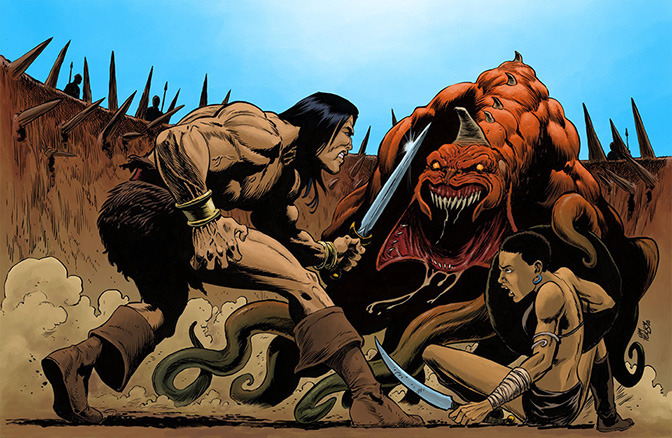
Thank you for allowing me into your working environment and entertaining these questions. This spring you were in France for the Angoulême International Comics Festival (Festival international de la bande dessinée d’Angoulême). This is one of those great gatherings for all interested in comics (bande dessinée). Were there any highlights in your experience?
It’s a pretty incredible occasion, just seeing that many people gathered for the love of comics. The passion is real, and you can feel it in the air. Having spent most of my life in the Midwest, just seeing the architecture there was a bit jaw dropping – but my real takeaway was creating friendships with and being inspired by the incredible artists I was lucky enough to meet. The fire runs deep.

Can we backtrack and discuss your youth and early experiences? What were you looking at? In initial glance at your style there’s a specific style that holds a strong reference to early EC horror comics of the 1960-70s, specifically Jack Davis and Wally Wood. This is good company. Their technique and application are clear edging toward monumental achievement through composition and great visual translation of stories. Do you see this?
I am a dedicated EC acolyte, there wasn’t a weak link in that lineup but I particularly gravitate toward Jack Davis’s energy. As a youngster I read the superhero stuff and John Romita Jr was probably the biggest influence on me, he’s an incredibly strong storyteller – always make it understandable. No need to get too confusing with the action, make it clear and make it good. I discovered Will Eisner much later, and his influence on me is deeply apparent and life changing – but I’ve always been most in awe of Bernie Wrightson. He left an impression on me since I saw his cover to TWISTED TALES as an adolescent. It horrified me like nothing ever had, and I was immediately hooked and have been so since.

You are a collector of a variety of ephemera (albums, books, and drawings). I was intrigued by your interest in Bernie Wrightson, Moebius, and Will Eisner. How do you see this habit informing your studio practice?
I’ve always had a bit of a collector’s mentality, and it’s stubbornly stuck with me into the digital and streaming age. There’s something about forming a physical and emotional attachment to a work that allows it to thread into my very life core. I’m talking about driving around for an entire summer with one tape in the car, just flipping it over once it’s done. I can feel the humid Wisconsin summer when I hear Purple Rain. The same with books, comics, movies… where did I find this piece? Was it a gift? Is there a story attached to when someone gave this book to me? It’s the magic of physical media, and it’s lost in the digital age. I saw a copy of The Stand at a horror convention, it was the original paperback that I’d read in the early 80s and the very weight of it brought back that era, being that age, having those fears and those excitements. It made me feel like a kid for a moment, for better or worse. Are you going to ruefully look through digital photos the way you would a faded Polaroid? I don’t know, maybe, but it’s not quite the same for me. I own a movie, I watch it over and over again… I stream something, it’s forgotten in a week. I didn’t use to be that way with movies, now I just eat them like fast food, for the most part. It’s a shame.
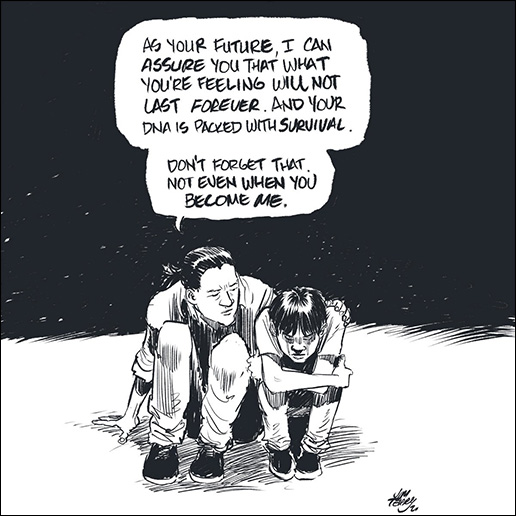
Your book, Come Home, Indio, was a spiritual journey. In reading this story you address a range of seminal topics – childhood in the suburbs of Chicago, your identity as an Indigenous person, battle with alcoholism, the death of your parents, and eventually a life-altering experience at Standing Rock. Simply put, what was your hope at closure of this effort?
Well, in my opinion the only good reason to do a memoir is in the hope that it might be helpful to someone else. Otherwise, I’m just an egomaniac who loves talking about myself, right? Or I’m trying to get you to like me. I’m not going to say I’m secure enough in myself not to do that, haha, but I was very aware of that insecurity and tried to integrate it into the work. The idea is, “I’ve been through this thing, I did this awful thing, I had this awful thing happen to me, but here I am today and I’m alright. I’m even laughing about a lot of it. If you’re in that place, there’s a little hope. No promises other than that nothing lasts forever, good or bad. And the pieces can be picked up.” At least, that’s what I was hoping for.
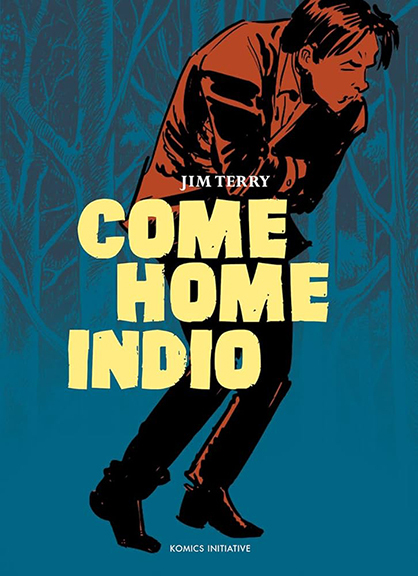
Can you describe your daily practice? What do you do from sunset to nightfall? What do you value most as a creator?
I get up pretty early and I read for an hour, drink the coffee, feed the cats, then get to work. I’ll work for a few hours on whatever it is I’m up to, then take care of life things, then work more. I leave the evenings open, generally, for whatever social things I’m doing. When it’s time to turn in a read myself to sleep… routine and structure are hugely important to me – when things are chaos and I’m out of my element the work tends to suffer. Get up and start doing the work, even if I don’t feel like it… sooner or later the love of what I do takes over and I won’t want to stop.
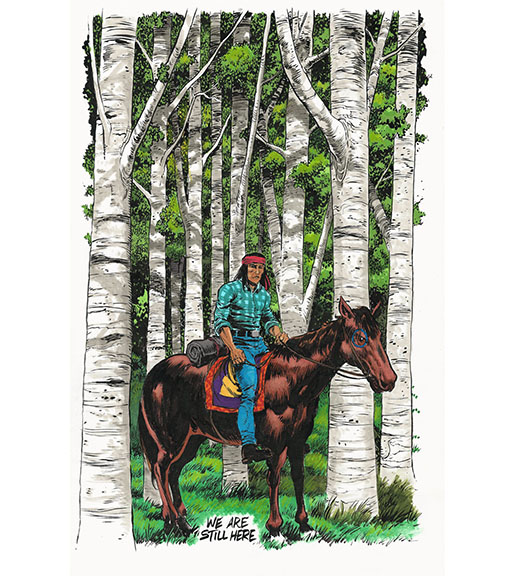
You have been asked by the Newberry Library to examine and create a work in response to the Edward E. Ayer collection. There are more than 11,000 pieces focused on this collection is one of the largest collections of books and manuscripts on American Indian and Indigenous Studies in the world. This undertaking sounds immense. How are you approaching this inquiry? What is your timeline?
The show is in September, and my work is due this early spring, so I’d better get moving! I initially just dove in, eclectically reading whatever seemed interesting but that very quickly overwhelmed me, so I started focusing on works pertaining to the Ho-Chunk (Winnebago) people, my people. It was a tough thing, going through so much fabrication, so much romanticism, so much racism and hatred and tragedy, this history that I didn’t know about… it was a lot. Now I’m going to create a comic that hopefully catches the vibe of what that stirred up in me. Bound to be a barrel of laughs, haha.

You are juggling many items, beyond the noted, you are working with Tim Seeley and Aaron Campbell on “West of Sundown” for Vault Comics. This book is essentially the antithesis of the Newberry Library project. Can you describe how you adapt from project to project? What is the biggest challenge?
Well, West Of Sundown has wrapped and I just finished illustrating a fantasy book with Tim and Slash (yeah, that one) called Deathstalker that’ll be coming out in April. I don’t find it difficult, jumping from tone to tone and matching that, it’s how I take in art. I enjoy Troma movies as much as I do Criterion, it’s all creative energy and I try to give it all the same amount of blood, sweat and tears.
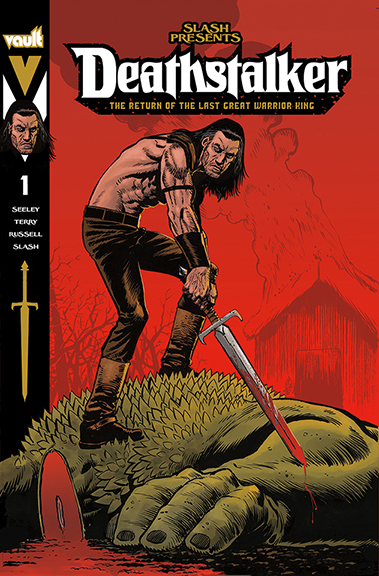
For additional information on the art and comics of Jim Terry, please visit:
Jim Terry – https://www.woundedbutdangerous.com
Jim Terry on Instagram – https://www.instagram.com/jimterryart/
Simon & Schuster Publishing – https://www.simonandschuster.com/authors/Jim-Terry/198375608
Chicago Public Radio, WBEZ – https://www.wbez.org/stories/how-one-indigenous-cartoonist-approaches-storytelling/4de4fe2d-7c99-4807-9d81-6a2fa85737c1
Big Cartel – https://jimterryart.bigcartel.com
Lion’s Tooth Publishing – https://www.lionstoothmke.com/come_home_indio.html
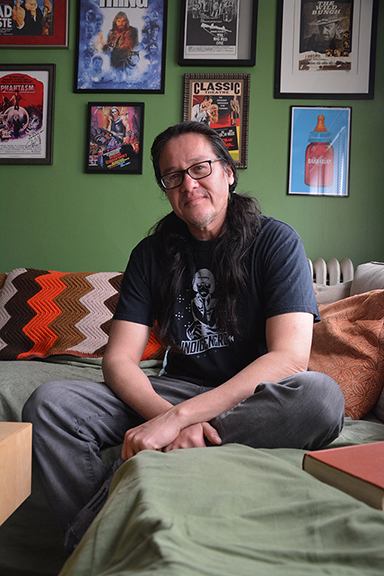
Artist intervew and portrait by Chester Alamo-Costello.


